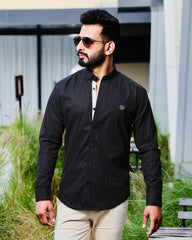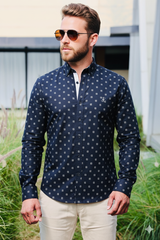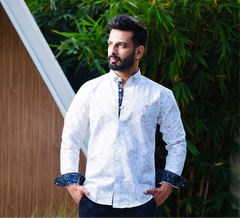Color coordination can make or break an outfit. The ability to match shirt and trouser colors effectively is essential for creating a polished, stylish appearance. Whether you're dressing for work, a casual outing, or a formal event, knowing how to pair colors will elevate your look and enhance your confidence. In this guide, we’ll share pro tips on how to match shirt and trouser colors like a fashion expert.
1. Understand the Color Wheel
To master color matching, start by familiarizing yourself with the color wheel. The color wheel is divided into primary, secondary, and tertiary colors, helping you understand how colors interact with each other.
- Complementary Colors: These are colors that are opposite each other on the color wheel. For example, blue and orange or red and green. Pairing complementary colors creates a vibrant, eye-catching contrast.
- Analogous Colors: These colors are next to each other on the wheel, such as blue and green or red and orange. Using analogous colors offers a more harmonious and subtle look.
- Monochromatic Colors: This involves using different shades and tints of the same color. For instance, pairing a light blue shirt with navy trousers creates a sophisticated, layered effect.
Understanding these relationships will help you make more informed color choices.
2. Consider the Occasion
The occasion often dictates how bold or subdued your color choices should be. Here’s a breakdown:
- Formal Events: Opt for classic and understated colors. For example, a white or light blue shirt paired with navy or charcoal trousers creates a timeless and professional appearance.
- Casual Outings: Feel free to experiment with brighter colors or patterns. A checked or patterned shirt can pair well with chinos or denim in a complementary or analogous color.
- Business Casual: This is your chance to balance professionalism with personality. A crisp, patterned shirt can be matched with trousers in a neutral tone, like beige or grey.
Always keep in mind the setting to choose appropriate color combinations.
3. Stick to Neutrals
When in doubt, neutral colors are your best friend. Neutral shades like black, white, grey, beige, and navy are incredibly versatile and can be matched with almost any color. Here’s how to incorporate neutrals:
- Neutral Shirt with Colorful Trousers: A white or grey shirt can be paired with vibrant trousers, making the pants the statement piece of the outfit.
- Colorful Shirt with Neutral Trousers: On the other hand, if you have a bold shirt, balance it out with neutral trousers to keep the outfit grounded.
Neutrals help create a balanced look while allowing for more freedom in color choices.
4. Consider the Season
Seasonal color palettes can influence your outfit choices. Here’s how to adapt your color combinations based on the time of year:
- Spring/Summer: Light and bright colors are perfect for warmer months. Pastel shades, soft blues, and light greens can be paired with lighter trousers for a fresh, airy look.
- Fall/Winter: Rich, deep colors like burgundy, forest green, and navy work beautifully in the cooler months. Pair these colors with darker trousers for a cozy, stylish outfit.
Understanding seasonal color trends will help you stay stylish and appropriate throughout the year.
5. Mix Patterns Wisely
Patterns can add interest to your outfit, but they require careful consideration to avoid clashing. Here are some tips for mixing patterns:
- Pair Patterns with Solids: If your shirt features a bold pattern, opt for solid-colored trousers. This keeps the look grounded and ensures that one piece stands out.
- Match Patterns: If you’re feeling bold, you can pair different patterns together. The key is to choose patterns with a similar color palette or scale. For example, a striped shirt can be matched with a subtle checkered trouser.
- Limit the Number of Patterns: To avoid overwhelming your look, limit the patterns to one or two pieces. This will create a cohesive and stylish outfit.
6. Utilize Textures and Fabrics
The texture and fabric of your shirt and trousers can influence color perception. Here’s how to utilize textures effectively:
- Different Textures: Pairing a textured shirt, like linen or chambray, with smooth trousers can create visual interest. For example, a linen shirt in a soft color can look stunning with tailored trousers in a complementary shade.
- Fabric Weight: The weight of the fabric can also affect color appearance. Lighter fabrics are great for summer, while heavier fabrics work well in winter. Make sure your fabric choices are appropriate for the season and occasion.
7. Experiment with Accessories
Accessories can enhance your outfit and tie the whole look together. Here’s how to use accessories to match colors:
- Belts and Shoes: Choose belts and shoes in colors that complement your shirt and trousers. For example, if you're wearing a light blue shirt and beige trousers, brown leather shoes and a matching belt create a cohesive look.
- Scarves and Ties: If you’re dressing up, consider adding a scarf or tie that pulls together the colors of your outfit. A patterned tie can work well with a solid shirt and trousers, adding a touch of personality.
Conclusion: Achieve Effortless Style
Matching shirt and trouser colors like a pro requires an understanding of color theory, an awareness of the occasion, and a touch of creativity. By following these tips and experimenting with different combinations, you’ll be able to create stylish, coordinated outfits that reflect your personality.
At Emerald Arrows, we offer a wide range of stylish shirts and trousers, perfect for any occasion. Visit our online store today to discover your next favorite outfit and elevate your style game! Shop now at Emerald Arrows!









